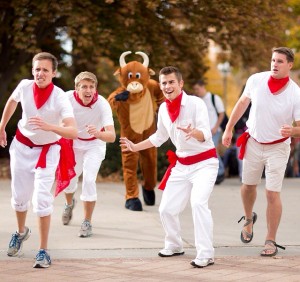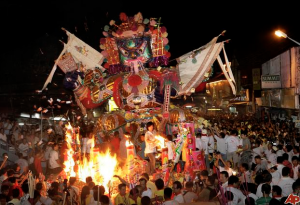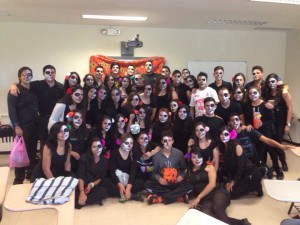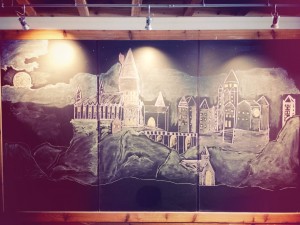
Jack-O-Lanterns, Dracula costumes, haunted houses and colorful candy are all traditionally associated with Halloween. But many countries around the world have a different idea of how to celebrate and remember the dead. Many foreign countries that do not celebrate Halloween will often have festivities to honor the deceased in some way.
An increasing number of countries have started to follow the American influence and welcome the pumpkins and other Halloween American traditions, but their own traditions and festivities live on.
Australia
Alex Boswell, a sophomore studying computer science who served in the Australia Sydney South Mission, said Halloween in Australia is very small when compared to the American celebration. He said most of the cultures in Australia are from all parts of the world because they’re first-generation immigrants, so Australia hasn’t picked up on the English culture “of what we know as typical” in regards to Halloween traditions.
Halloween in Australia is closer to being just like another normal day, Boswell said. “There might be a costume party here or there but decorating houses, passing out candy and watching Halloween movies just isn’t that big,” he said.
Boswell said he still prefers an American Halloween, as in Australia it takes a few houses to find someone who is actually passing out candy.
China
Kanokphol “Young” Limpanasriphong, a 24-year-old BYU student from Thailand, spent one-third of his life in the Chinese capital of Beijing. Young said China does not typically celebrate Halloween, although some stores sell pumpkins and orange decorations for the occasion.
“In China, they believe in spirits and worship their ancestors,” Young said. “Chinese are really respectful of the dead and it’s not about partying.”

In April, the Chinese give their respect to the dead during a traditional festival called Qingming, similar to Memorial Day. On this special occasion, people visit family members who have passed and clean their graves. “People usually do not dress as colorful as usual,” Young said. “They dress up in dark, simple colors.”
When people are done paying homage to their ancestors, it is the spirits themselves who come to pay a visit to their descendants during another festivity called the “Ghost Festival,” according to Young. Celebrated in July, the Ghost Festival is a time when spirits come down to visit the living and are welcomed back by their descendants with food, music and rituals.
Russia
Reyna McGhie, a BYU student studying pre-nursing, lived in Moscow, Russia for about eight years. She said because she was around Americans in Moscow, she grew up celebrating Halloween like her American compatriots. But outside the “American bubble,” Halloween in Russia is more of an “adult holiday.”
McGhie said Russian children don’t typically dress up or go trick-or-treating, but their parents and other adults will. Halloween is the occasion for adults to dress up and go out for a drink at bars and night clubs.
Netherlands

As in most European countries, Halloween in the Netherlands is seen as an American holiday. But one small Dutch town is the exception.
Just 40 minutes south of Amsterdam, the town of Wassenaar is home to many embassies and gathers an important expatriate community. McGhie, who moved to the Netherlands after living in Russia, said the town was an important center during Halloween.
“Dutch people knew Wassenaar had lots of foreigners, so they would come to Wassenaar from all around to go trick-or-treat,” she said. Her house, located on the popular street of Storm-van’s-Gravesandweg, would receive up to 400 or 500 people knocking on the door in one night.
Lara Fernandez, native to the Netherlands, said the closest thing to Halloween the Dutch celebrate is an event called “Sint-Maarten” or Saint Martin’s Day. Celebrated each year on Nov. 11, the festivity is highly celebrated in some Netherlands regions and virtually unknown in others. Most of the time children walk around the neighborhood with hand-crafted lanterns, knocking on doors and singing traditional songs such as “Sinte Sinte Maarten,” in hopes to get paid in candy.

Mexico
American Halloween traditions are celebrated in some northern parts of Mexico closer to the U.S. But people more widely celebrate the “Dia de los Muertos” or “Day of the Dead,” which takes place Nov. 2. According to Evelyn Acosta Maldonado, native of Chihuahua, Mexico, people make altars for the dead and celebrate what the dead enjoyed during their lives.
“The altar is put in houses and decorated with paper and traditional food or food the dead person liked,” Maldonado said. “Candles are lit to illuminate the path so that the dead person can arrive. Everybody dresses up like skulls, too.”
Spain
Sara Arjona, a Spanish student studying at the University of Alcala de Henares, said people in Spain don’t celebrate Halloween as much. Instead, the Spanish culture is rich in traditional legends such as “El monte de las ánimas” and “Don Juan Tenorio,” a drama usually played in theaters. Arjona said people tend to focus more on Nov. 1, when people go to churches and cemeteries to honor their dead.
“Some people may be worried at home because of the legends, others stay at home just to respect the memory of their dead relatives,” she said.
Arjona said people also eat traditional desserts such as “huesos de santo,” or “Bones of the Saints,” and “buñuelos,” which are fried dough balls, to celebrate the All Saint’s Day.

England
Jakob Walker, a senior studying public relations, was born in Gorleston, England and now attends BYU. Walker said the biggest difference between traditions in England and the U.S. does not just involve Halloween.
Haiti
Some might go door-to-door and ask for candy on Halloween, but according to Haitian Almyr Jules, people mostly use the day to remember the dead and think about lost loved ones. Almyr said about a week before Oct. 30, people clean graves in the cemeteries to make them look nice.
Then on Oct. 31, their ‘The Day of the Dead,’ people attend a Catholic mass because of the large Catholic influence in Haiti. Many will worship before going back to the graves to visit their lost ones.
Brazil
In Brazil, Halloween remains an American holiday rarely celebrated. David Amorim, originally from Sao Paulo, said Halloween as Americans know it, is sometimes celebrated in more privileged neighborhoods where people are more aware of international holidays.
“This is mainly due to an American cultural influence in Brazil, perhaps propagated by the media and English-speaking schools in major cities,” Amorim said. “But you won’t see any candy or costume sales, or Halloween-themed parties, or anything of that sort.”
America
Trick-or-treating, pumpkin carving and bobbing for apples are classic Harvest-time activities related to Halloween. BYU students usually dress up on campus, but this year, Halloween falls on a Saturday. Downtown Provo festivities will include trick-or-treating on Center Street, a show at the Velour and a pumpkin parade at the Riverwoods.




